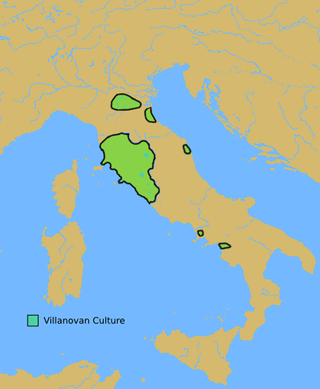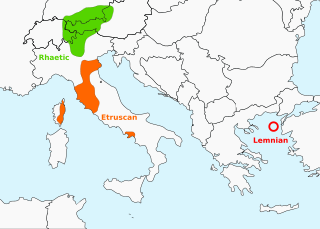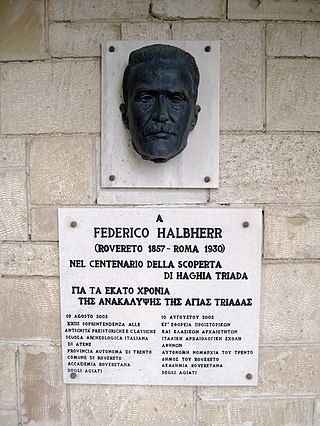Related Research Articles
Mauro Cristofani was a linguist and researcher in Etruscan studies.

The Villanovan culture, regarded as the earliest phase of the Etruscan civilization, was the earliest Iron Age culture of Italy. It directly followed the Bronze Age Proto-Villanovan culture which branched off from the Urnfield culture of Central Europe. The name derives from the locality of Villanova, a fraction of the municipality of Castenaso in the Metropolitan City of Bologna where, between 1853 and 1855, Giovanni Gozzadini found the remains of a necropolis, bringing to light 193 tombs, of which there were 179 cremations and 14 inhumations.

Vetulonia, formerly called Vetulonium, was an ancient town of Etruria, Italy, the site of which is probably occupied by the modern village of Vetulonia, which up to 1887 bore the name of Colonnata and Colonna di Buriano: the site is currently a frazione of the comune of Castiglione della Pescaia, with some 400 inhabitants.
Giovanni Becatti was an Italian Classical art historian and archaeologist.
Mario Torelli was an Italian scholar of Italic archaeology and the culture of the Etruscans. He taught at the University of Perugia.

Massimo Pallottino was an Italian archaeologist specializing in Etruscan civilization and art.

Tyrsenian, named after the Tyrrhenians, is a proposed extinct family of closely related ancient languages put forward by linguist Helmut Rix (1998), which consists of the Etruscan language of northern, central and south-western Italy, and eastern Corsica (France); the Rhaetic language of the Alps, named after the Rhaetian people; and the Lemnian language of the Aegean Sea. Camunic in northern Lombardy, between Etruscan and Rhaetic, may belong to the family as well, but evidence of such is limited. The Tyrsenian languages are generally considered Pre-Indo-European and Paleo-European.
The Fanum Voltumnae was the chief sanctuary of the Etruscans; fanum means a sacred place, a much broader notion than a single temple. Numerous sources refer to a league of the "Twelve Peoples" (lucumonies) of Etruria, formed for religious purposes but evidently having some political functions. The Etruscan league of twelve city-states met annually at the Fanum, located in a place chosen as omphalos, the geographical and spiritual centre of the whole Etruscan nation. Each spring political and religious leaders from the cities would meet to discuss military campaigns and civic affairs and pray to their common gods. Chief amongst these was Voltumna, possibly state god of the Etruria.

The Swedish Institute in Rome is a research institution that serves as the base for archaeological excavations and other scientific research in Italy. It also pursues academic instruction in archaeology and art sciences as well as arranging conferences with themes of interest to the institute. The Institute has at its disposal a building in central Rome with a relatively well-supplied library, archaeological laboratory and around twenty rooms and smaller apartments for the use of visiting researchers and holders of scholarships.
Larissa Bonfante was an Italian-American classicist, Professor of Classics emerita at New York University and an authority on Etruscan language and culture.

Etruscology is the study of the ancient civilization of the Etruscans in Italy, which was incorporated into an expanding Roman Empire during the period of Rome's Middle Republic. Since the Etruscans were politically and culturally influential in pre-Republican Rome, many Etruscologists are also scholars of the history, archaeology, and culture of Rome.
Nancy Thomson de Grummond is the M. Lynette Thompson Professor of Classics and Distinguished Research Professor at Florida State University. She specializes in Etruscan, Hellenistic and Roman archaeology. She serves as the director of archaeological excavations at Cetamura del Chianti in Tuscany, Italy. Her current research relates to Etruscan and Roman religion, myth and iconography.

Federico Halbherr was an Italian archaeologist and epigrapher, known for his excavations of Crete. A contemporary, good friend, and trusted advisor of Arthur Evans, he began excavating at Phaistos before Evans began excavating at Knossos. Some of his explorations were funded by the Archaeological Institute of America.
Poggio Colla is an Etruscan archaeological site located near the town of Vicchio in Tuscany, Italy.
Judith Swaddling is a British classical archaeologist and the Senior Curator of Etruscan and pre-Roman Italy in the Department of Greece and Rome at the British Museum. She is particularly known for her work on the Etruscans, and the ancient Olympic Games.
Maria Bonghi Jovino is an Italian archaeologist. Bonghi Jovino was Professor of Etruscology and Italic Archaeology at the University of Milan.
Carlo De Simone is an Italian linguist, specializing in Ancient Greek and Latin texts and Etruscan epigraphs. He is best known for his research into Etruscan, Lemnian and Rhaetian languages.

Istituto Nazionale di Studi Etruschi ed Italici is a cultural institution based in Florence, Tuscany, Italy. It was founded in 1925 with the aim of promoting and enhancing in Italy and worldwide studies on the Etruscan civilization and other peoples of ancient Italy.
Jean MacIntosh Turfa is an American archaeologist and authority on the Etruscan civilization.
Guglielmo Maetzke was an Italian archaeologist and etruscologist. A pupil of the Etruscologist Massimo Pallottino, he directed important excavation campaigns in Tuscany, Lazio, Campania and Sardinia.
References
- 1 2 3 Camporeale, G. (1979). "Luisa Banti" (PDF). Studi Etruschi. 47 (3): ix–xv.
- 1 2 "Breaking Ground: Women in Old World Archaeology - Luisa Banti". Brown University.
- 1 2 3 "Banti, Luisa". Dictionary of Art Historians.
- ↑ De Grummond, Nancy T. (2015). "Banti, Luisa (1894-1978)". Encyclopedia of the History of Classical Archaeology. Routledge. p. 116. ISBN 9781134268542.
- ↑ Richardson, Emeline (1975). "Reviewed Work: The Etruscan Cities and Their Culture by Luisa Banti, Erika Bizzari". The American Journal of Philology . 96 (4): 431–433. doi:10.2307/294507. JSTOR 294507.
This is the first English translation of one of the contemporary classics of Etruscan studies. Miss Banti's Il mondo degli Etruschi...has informed and profoundly modified scholarly opinion for the past fifteen years.